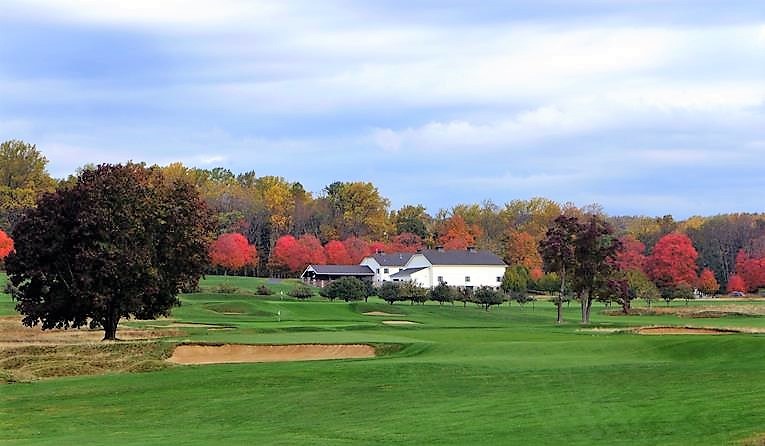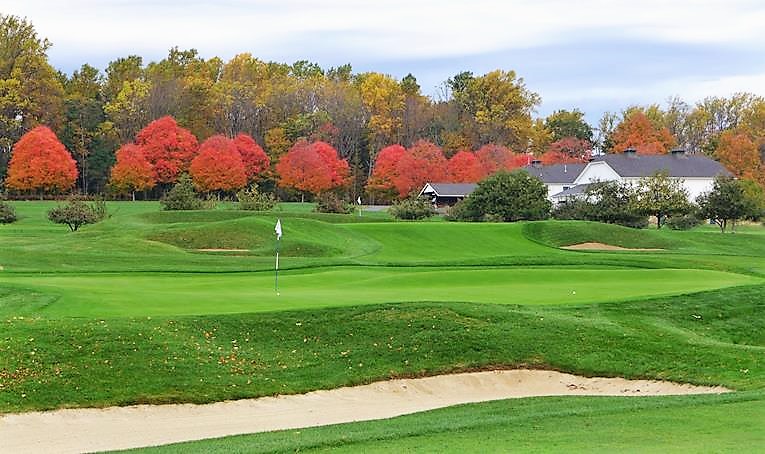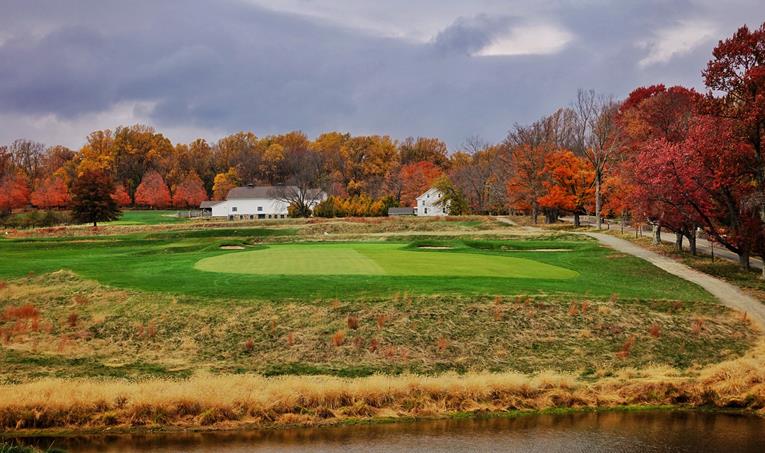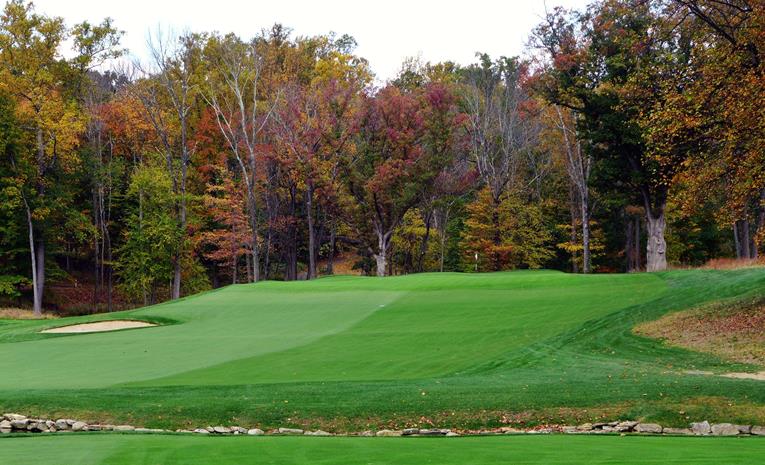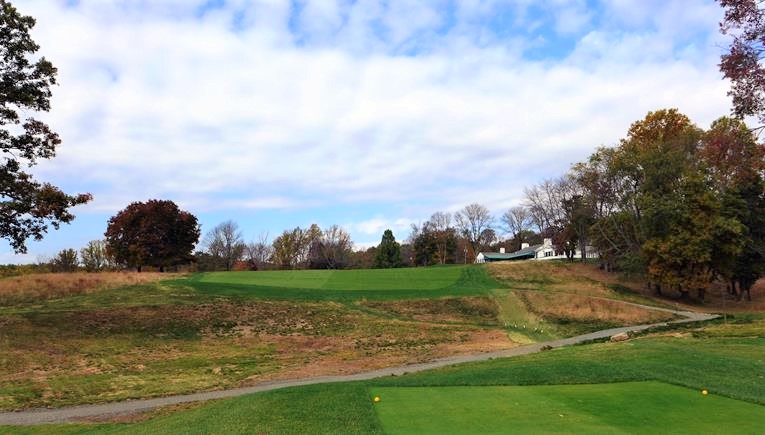Somerset Hills Country Club
New Jersey, United States of America

Even after 100 years, Somerset Hills remains what it has always been: a pinnacle of design in America.
One of the reasons architecture flourished during the Golden Age of architecture was that it attracted those who loved the game for the game’s sake. Charles Blair Macdonald, Albert Warren Tillinghast, and George Thomas possessed a far different – and healthier – interest in the welfare of the game than did developers that followed in the 1960s-1990s, intent on profiting from the sport by selling residential properties. Though money has become the curse of this great game, it didn’t drive these Golden Age titans. Rather, they worked for little or no design fee, with their reward being to see the nascent sport flourish in their home country.
Macdonald expressly set out to build template holes that borrowed design features from his favorite holes in the United Kingdom. While Tillinghast was also keen to see the best attributes of the game transplanted across the pond, he did so mostly through original adaptations. One result is that his work is fabulously impossible to stereotype with the player hard pressed to believe that the same architect designed the courses at Winged Foot, the three nines at Ridgewood, the courses at Baltusrol, San Francisco Golf Club, Bethpage (Black) and Somerset Hills. Think of the striking features of each: Winged Foot (West) with its raised, wickedly contoured greens and proportionately deep greenside bunkers; Ridgewood, with its holes interacting off a major spine, Baltusrol (Lower) which enjoyed a rustic, low-profile look in Tillinghast’s day; San Francisco with its stylishly flashed bunkers placed at all sorts of angles within broad fairways; Bethpage (Black) with its sprawling scale and Somerset Hills with its intimate layout. Tillinghast’s very lack of identifying characteristics make his work desperately difficult to brand, while simultaneously elevating it to the top of his profession. Only a handful of architects possess a body of work that sniffs at what Tillinghast accomplished.
Born into a well-heeled family in Philadelphia in 1876, Tillinghast was unfortunate only in the sense that even as a teenager, golf barely existed in America. The score of courses that existed were rudimentary at best. In his book Albert Warren Tillinghast: A Timeline of his Life and Work, Tillinghast expert and historian Phil Young neatly lays out how Tillinghast’s interest progressed from player to architect. Tillinghast took up the game sometime between 1890 and 1895. In 1895, he traveled to Scotland with his parents and his bride. This wasn’t his first trip overseas (he had been to England as a four year old) but it represented the first time that he met the legendary Old Tom Morris in St. Andrews. A few years later on his 1898 trip, he had the privilege to spend considerably more time with Old Tom. Upon returning home, he was invited to build a basic course at Frankford on a municipal park outside of Philadelphia. From 1900 to 1905, Tillinghast competed in many golf events and in 1905, he was awarded the Silver Cross medal by the Golf Association of Philadelphia as the outstanding player of the year. Little wonder as Tillinghast went undefeated in team events that year!
Young goes on to chronicle how Tillinghast transitioned from player to writer to architect from 1910 to 1917. Tillinghast sketched holes and his writings are scattered across many periodicals. Along with Shawnee-on-Delaware, Somerset Hills was one of his first eighteen hole designs and it opened for play late in 1916. There was no more exciting decade in the state’s golf history, with Pine Valley taking shape to the south and Somerset Hills in the north.
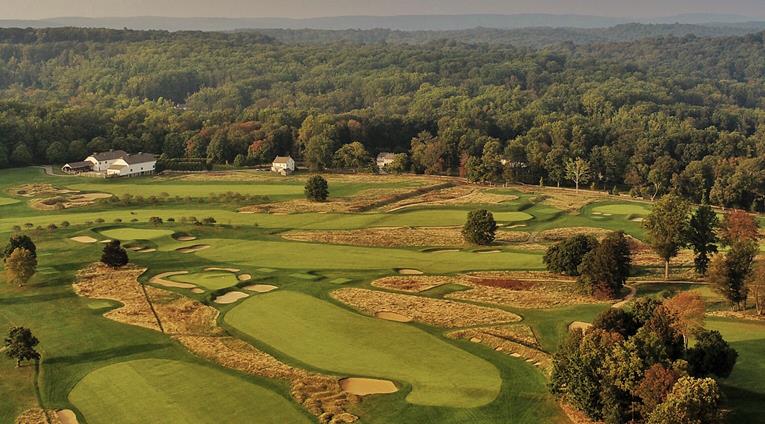
With golf like this, Tillinghast was one of the prime instigators in making inland golf (nearly) as compelling as links golf.
For sure, variety is the cornerstone to Somerset Hills: variety of terrain, variety of length of holes, variety of approach shots and variety of greens. With the open front nine laid on and around an old racetrack and the back nine through rolling wooded terrain with streams and a pond, one would think the course could have a Jekyll and Hyde character (as with, for example, Spyglass Hill). However, the course flows well, and members are split over which side they prefer.
The par threes are well balanced at 205, 230, 150 and 170 yards and it is always nice to find a set with at least 20 yards difference between all four holes. Such variety is further amplified with the two shot holes. A teaser on each nine (the fifth and eighteenth) mixes in with the brawny ones (the first, fourth, seventh, thirteenth, and fourteenth). Special accolades are deserved as well for a set of holes rarely discussed today, namely those in the 370 to 415 yard range. Such holes lend a course much of its fabric and appeal for regular club play. Headlined by the eleventh and fifteenth holes, the medium length two shotters are a hallmark of the course.

How good are the one shotters at Somerset Hills? The one above (the 16th) is the least talked about!
Somerset Hills enjoyed the reputation as ‘a sleepy club’ when the author lived in Bernardsville in the mid-1980s. It probably still cherishes that moniker today but now there is a laser-like focus on getting the fine points right in regards to course presentation. Such attention to detail started in earnest in the 1990s when the club set about clearing interior, non-indigenous pine trees. Only two remain today. They hired Tom Doak’s Renaissance Golf Design in 2004 and Brian Slawnik has been the point man since. Ryan Tuxhorn, who trained at Merion, was hired as the Green Keeper in 2008 and he and Slawnik have formed a tight bond. Per the Green Committee Mission statement, no major work occurs without Slawnik’s input. Alas, Hurricane Sandy didn’t ask permission and 200 trees were lost in 2012. The club has planted indigenous hardwoods around the perimeter and wisely maintained the secluded, woodland theme on the back nine that the course enjoyed in Tillinghast’s day.
The above series of events (e.g. the deforestation of the interior of the course, the hiring of Renaissance and then Tuxhorn) set the stage for fairway width to be recovered and for the greens to be recaptured. It is a story played out scores of times across America over the past two decades but it is all the more compelling here because we are dealing with a Tillinghast masterpiece rich with neat design features. As sunlight and wind replaced trees and shade, the newly reclaimed playing surfaces hardened and firm and fast playing conditions were once again on the menu. When Tillinghast supervised construction in 1916, that is the brand of golf with which he held in highest esteem. He laid the course out accordingly and so many of his features – starting with the intriguing land movement thirty yards prior to the open first green – were built expressly for bouncy-bounce golf.
Increasing fairway width is not as easy or straightforward as it may seem. Done judiciously, the original architect’s features and playing angles are restored and the design thrives. Done indiscriminately, and maintenance costs mushroom for no real purpose. As Slawnik staked out where he would like to see the fairways expanded, Tuxhorn balanced the equation by recycling fairway turf that was too close to tees to provide value. By redeploying the unused fairway turf to the sides of holes to enhance playing angles, Tuxhorn pulled off the very neat trick of restoring Tillinghast’s strategy without increasing the total amount of fairway acreage that his team maintains. This was a complete win for the club and how thrilled Tillinghast would be to see Somerset Hills today.
Another reason the course is so good is because it has not sought outside events. Other Tillinghast courses in the Met area eagerly seek major televised events and the damage that has been done to Tillinghast’s design principles manifests itself in artificially narrowed fairways and tree plantings. Somerset Hills has long gone the opposite route by concentrating on enhancing the member’s playing experience. One green (the tenth) is no longer in its original place but otherwise, the course is as authentic to its Golden Age roots as any. A Green Committee member sums it up beautifully (!) when he notes, ‘ It would take an act of God to make us alter any of our 17 Tillinghast greens.’
David Eger, who has played Somerset Hills numerous times especially when he was the Senior Director, Rules Competition for the United States Golf Association in nearby Far Hills, marvels at the putting surfaces, noting, ‘Each of the original 17 putting greens is great in its own right and even better, each features unique slope and contours from one another. That helps make Somerset Hills among my very favorite “fun” courses to play. It’s right up there with Cypress Point, Seminole, Fishers Island, Camargo, Shore Acres, Crystal Downs, Garden City and Valley Club.’
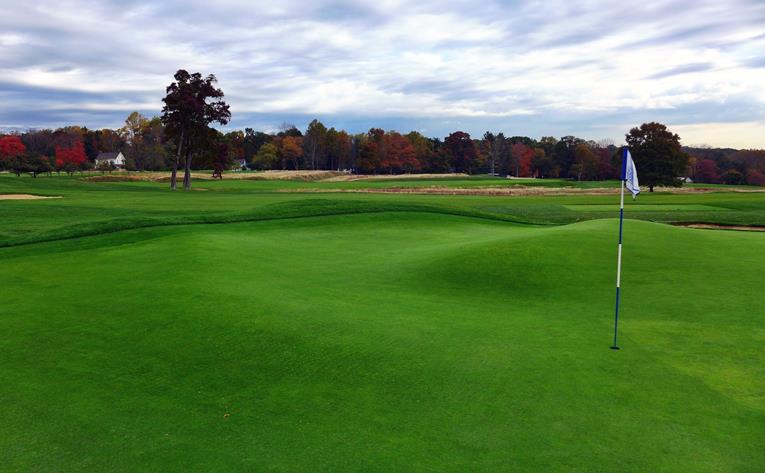
Tillinghast joins MacKenzie, Maxwell, Ross, Travis, Coore and Doak in the pantheon of great green builders. Above is the 5th green.
Young quotes from Tillinghast himself when he writes, ‘If you were asked to explain Tilly’s philosophy of designing a golf hole in a single sentence, how would you put it? The idea seems an impossible task, yet Tilly, in answering a question during an interview with a reporter from the Boston Herald did exactly that. He stated, “The one shot that tells the story in golf is the shot to the green, and if you conceive of golf being a game of animate attack and inanimate defense with regard to that shot, you have my design in a nutshell.” At Somerset Hills, each hole appears to flow out of the land rather than having been built into it. Michelangelo, in describing how he sculpted stone, said, “Every block of stone has a statue in it and it is the task of the sculptor to discover it.” Not only is that true of the golf course architect, but Tilly’s design here is a true example of that rarest of tasks accomplished.’
These comments from an ace player in David Eger and a historian in Phil Young highlight the range of Somerset Hills’ appeal and pointedly suggest that to understand Tillinghast’s genius as an architect, Somerset Hills is where a student of architecture must head.
Holes to Note
First hole, 460 yards, Orchard; Hugely underrated, this two shotter will never receive its proper due as the course’s most famous hole follows it. Nonetheless, this opener deserves applause. First, it is worth noting that it dispels one of the knocks of courses built in the 1910s: namely, a lack of doglegs. Somerset Hills possesses an abundance of such and many of them (here, nine, eleven, and fifteen) are among the course’s finest holes. Second, the golfer is immediately introduced to one of the design’s most beguiling elements: a green that is open in front. Bear in mind that Somerset Hills was built in the middle of the age of hickory golf; steel shafts weren’t yet a dream, much less a reality. American architects in the 1910s were mindful of the sport’s nascent roots and mindfully provided designs that would accommodate a wide range of playing levels. Such flexibility provided the foundation for golf to explode in popularity from coast to coast during the next decade when the economic boom created the ‘Roaring 20s.’ Even though the first is sturdy (it was a par 5 in Tillinghast’s day), its open green can be accessed in every possible manner and Slawnik refers to the contours feeding onto the putting surface as ‘genius stuff.’ The author has coined the phrase ‘inclusive architecture’, meaning architecture that welcomes all to the game while being engaging for the best club golfer. Somerset Hills epitomizes inclusive architecture and should be heralded as a design ideal because it is the perfect course for youths through seniors.
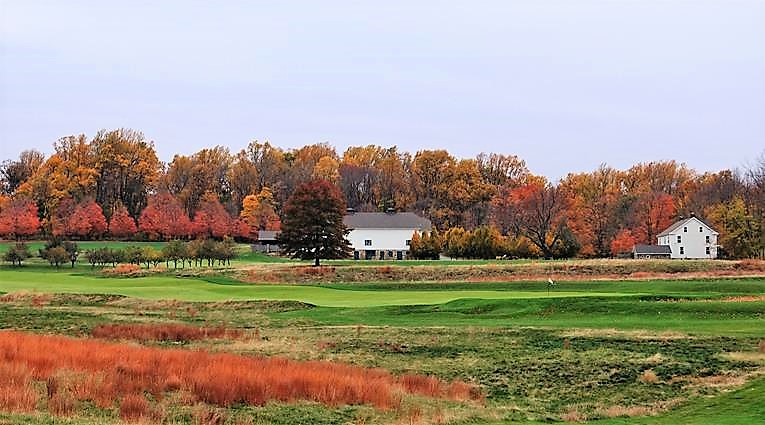
The exquisite fairway contours are evident in this view from the side of the 1st fairway. One thing is for sure: a bulldozer never wrecked this land.
Second hole, 205 yards, Redan; Tillinghast, like Macdonald, made many pilgrimages to Great Britain. Like Macdonald, Tillinghast was over-the-moon in awe of Ben Sayer’s Redan hole at North Berwick. No surprise then that Tillinghast and Macdonald produced the two finest versions in the United States. Indeed, though it may be sacrilege to suggest, the author contends the fourth at National Golf Links of America and the second here are better than the original. This one is set over land that begs for it but only if you knew what you were looking for. An American architect who hadn’t traveled to Britain would have been clueless as to the hole/site’s potential. Two absolute no-nos here are a miss short or one right. The cant of the green from the right to left is as severe as any Redan with which the author is familiar. Tillinghast’s own take on Redans was that ‘some of the most interesting holes are those where the best line of the flag is not direct.’ He never produced a better example of that philosophy than at Somerset Hills. This hole is joined in that pursuit by the seventh and eleventh where the aim is well right of where the golfer wishes the ball to finish. The first two holes highlight that using the ground is integral toward success.
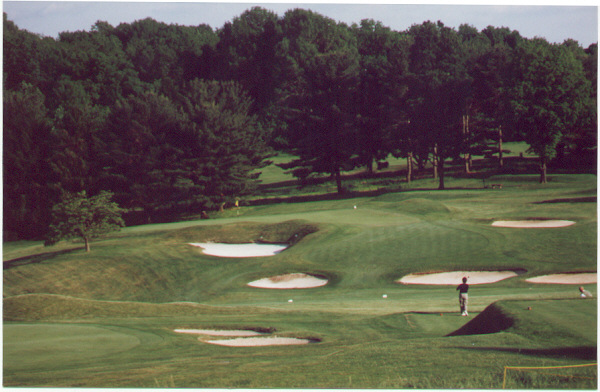
The Redan seen pre-2000 and …
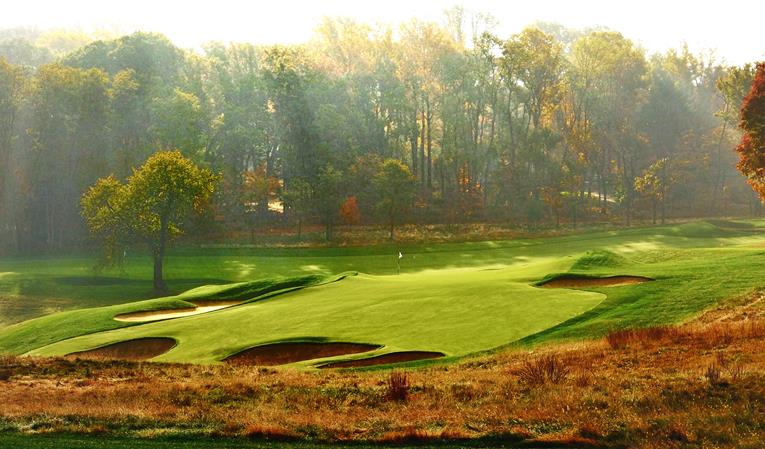
…today! A tee ball short tumbles backwards fifteen yards into the bunkers at the base of the hill. That generally proves to be the start of an unfortunate – and lengthy – series of shots.
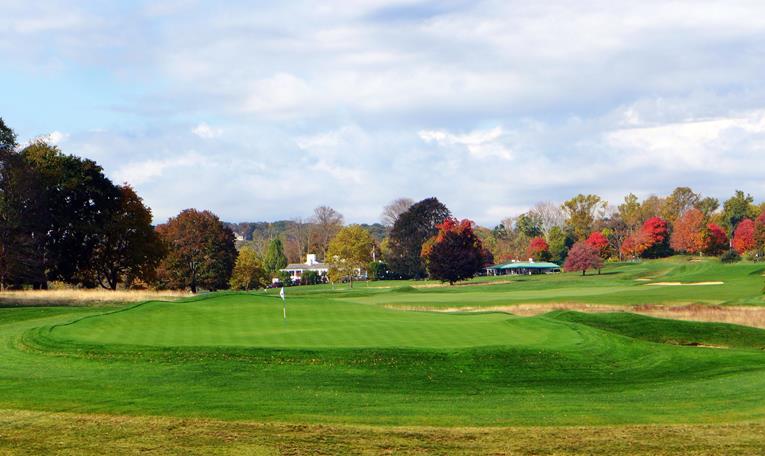
Some Redans center around a tilted putting surface that runs from front right to back left. The one at Somerset Hills certainly is that but it also is more nuanced with plenty of random rolls and hollows as seen in this view from behind.
Fourth hole, 460 yards, Dolomites; Standing on this tee, the player is delighted to discover that his drive that will catch a down slope and scamper toward the green. That cheery thought is soon replaced by the stark reality of an uphill approach to a green with the most fierce back to front slope on the property. In the American Cricketer, Young found an article where Tillinghast quotes from Henry Leitch who talks about the Alpinization of the hazards at Mid-Surrey outside of London. Such random, irregular mounding also greatly influenced Stanley Thompson, as we learned from the October 2018 Feature Interview with Dr. James Taylor. Irregular mounding is littered across the course but nowhere more liberally and attractively than this hole, hence its name.
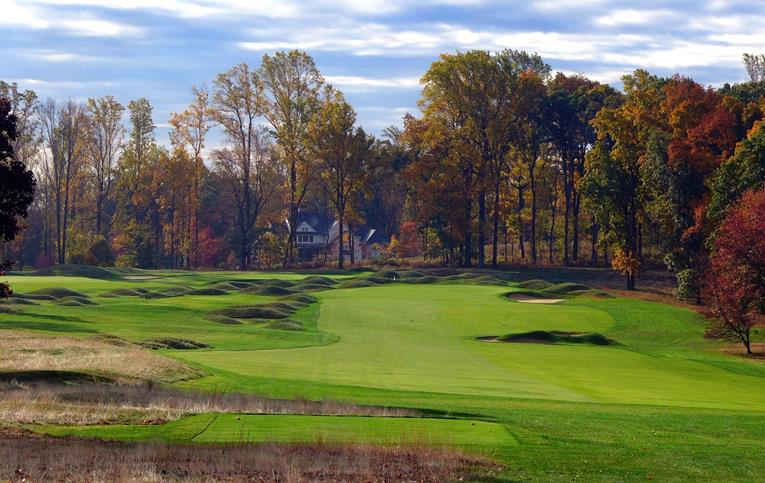
A perfect use of a valley with the tee ball descending into it and the approach climbing out on the far side. The star of the photograph are the dolomites and the green which is glued to the ground at grade – and is fiendish because of it.
Fifth hole, 350 yards, Nairn; This green with its dramatic two foot rolls toward the rear are unabashedly wonderful features and only could have come from someone who had the opportunity to soak up the dramatic interior green contours at courses like North Berwick and The Old Course. Indeed, Tillinghast named the holes here, so clearly one of the greens at Nairn was in his mind at the time. Tillinghast died in Toledo, Ohio in 1942 and despite the hundreds of courses he both designed and re-designed, he never built a more joyful set of putting surfaces than the ones here. One possible explanation as to why he didn’t is that the world changed. The Great Depression snuffed the joy out of life for a while and World War II did worse. Congratulations to the club for being great custodians, literally for being the Keeper of the Greens and for eschewing shortcuts.
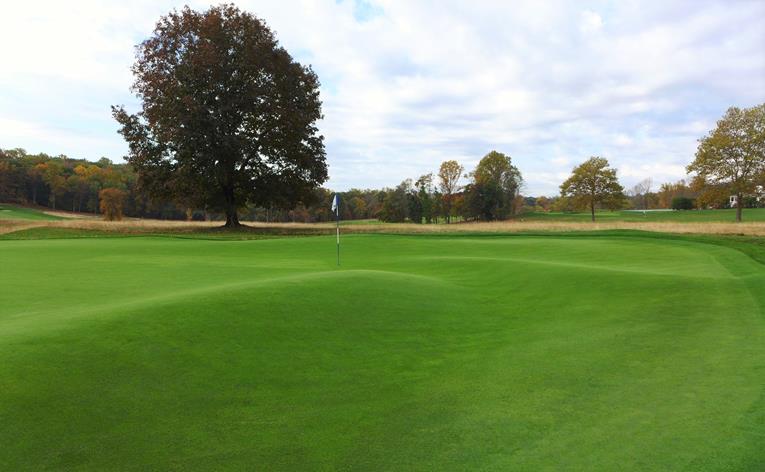
… the green! The hugely appealing rolls in the back of the 5th green feel like something straight from Scotland – and that is not a coincidence.
Seventh hole, 495 yards, Racetrack; As with the eighth at Pebble Beach, the visually uninteresting uphill tee shot is significant because the player dearly wants to catch one so he can enjoy the smashing approach. While most players do not relish long, 200+ yard approach shots, Tillinghast had the unmatched ability to make them appealing – no architect was clearly better. Not enough praise can be heaped on the one here as it ticks all the important boxes: it is dramatic in an unforced manner, it rewards creativity and bold play, it’s perfectly presented, and it is fun for all. Congratulations to Slawnik and the green keeping staff for getting the mow lines corrected from the 1980s version that the author knew. Before, the fairway failed to extend sufficiently to the right of the green and thus the player was robbed of using the land’s strong right to left pitch to his advantage. Now, especially with the course enjoying such firm playing conditions under Tuxhorn for the past decade, the hole encapsulates Tillinghast’s stated ideal of hitting toward point A to have the ball end by Point B. The kind of ‘plop and splat’ golf offered at most inland, clay-based courses pales in comparison. Any course would love to claim this world beater for itself.
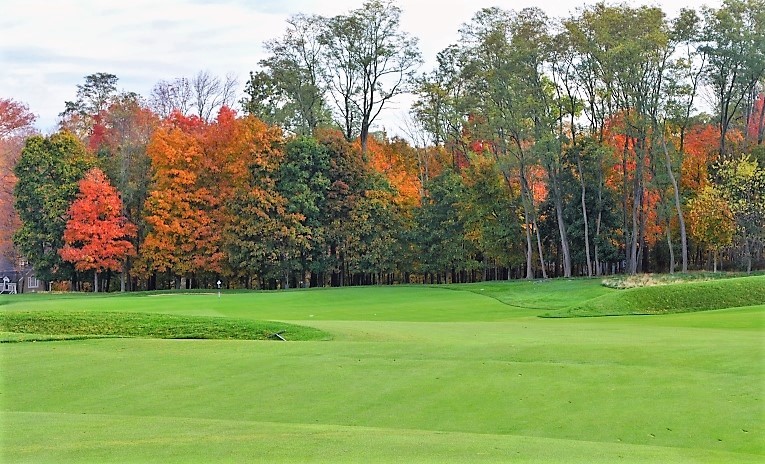
The approach to the 7th: the right to left tilt of the ground and the flag floating in a sea of short grass epitomize what ground game options can bring to a course. Two good golfers from the same spot in the fairway could play shots to land as far apart as 60 yards (!) and end with the same appealing result.
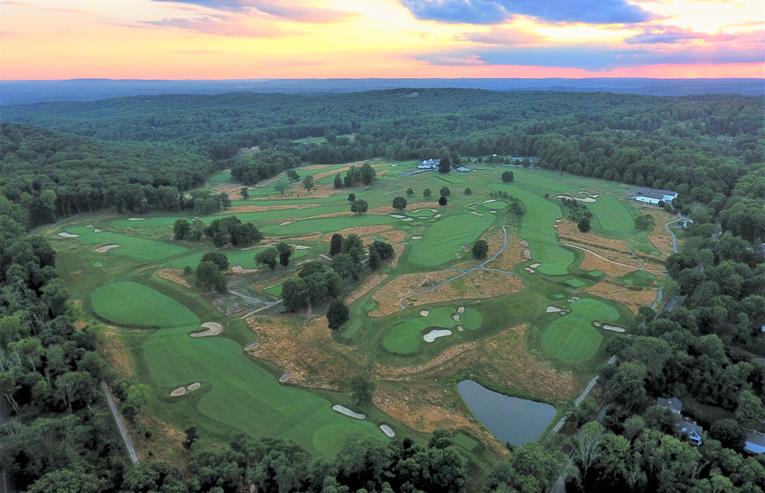
The 7th tumbles down the hill from the left, the 8th plays across the valley with the pond and the long ninth bends left in the distance and returns the golfer to the professional shop. The interesting thing? The golfer plays the course’s longest two shotter, longest one shotter and longest three shotter in succession. The author struggles to think of another course where the same is true.
Eighth hole, 230 yards, Dip; The best architecture need not be complicated. If the architect can get the routing right (a huge if, mind you), then much of the rest follows seamlessly. Take this hole as an example. The tees and putting surface are at grade with their surrounds and are separated from each other by a broad valley with a pond at the bottom. A big thump is required and the valley lends the hole its visual appeal. Made-made, irregular mounds with bunkers cut into them are features that enchanted Tillinghast from his trips to England and he used them here to add playing interest to the otherwise flat green surrounds. All told, this effortlessly demanding hole was likely ‘built’ in just a few days and it feels like it has been there for a century which, of course, it has.
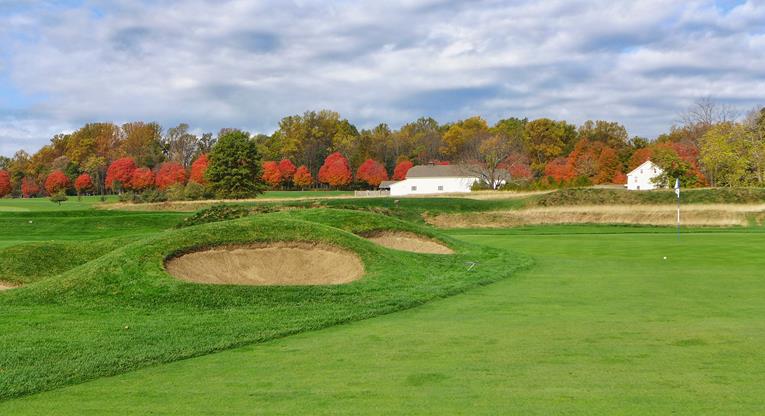
The Golden Age architects were adept at cutting bunkers into landforms and making them look like they were part of the landscape. The ones at the 8th are not such an example: they are patently man-made and are all the better for it.
Ninth hole, 530 yards, Westward Ho; Working with Slawnik, the club has gained an important couple hundred yards in length. Additionally, tee pads have been suppressed, or lowered to the ground. The combined result is that Somerset Hills plays surprisingly long and that many of its design attributes remain in play. Take this hole as an example: length coupled with the suppressed tee has brought a key design feature back into play, namely Tillinghast’s Sahara concept. Today, a tee ball needs to find the fairway or carrying the Sahara on one’s second shot becomes problematic. Not only that, but pushing the tee back shortened the walk from the prior green, which is always a good thing. Thirty years ago, the ninth tolerated looser golf but no more. One assumes that Tillinghast’s visit to the fledgling Pine Valley in 1913 played a role in the creation of this Sahara.
Eleventh hole, 415 yards, Perfection; Though the tenth green has character, it isn’t a Tillinghast. Not to worry though for four of his all-time finest greens now follow, starting with this one. On the tee, the tenor of the property changes as it goes from open to forested and the tiger looks to hit a controlled fade close to a creek on the inside of the dogleg, leaving him an 8-iron to the green. The less talented play more to the center of the fairway and take their chances with a mid-iron to this extravagantly undulating green. Either way, both golfers face a charismatic approach shot. Aptly named, this hole joins the second, fourth, seventh, twelfth, fourteenth, and fifteenth as seven all-world holes.
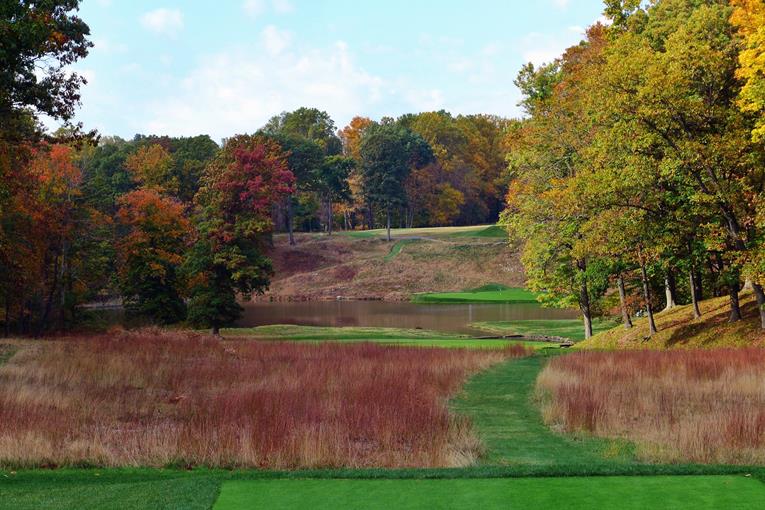
For many, their favorite stretch in inland golf commences with the downhill tee shot at 10 at Augusta National and concludes with the shot over water to the 16th. That’s how the author feels about the stretch of 11-16 at Somerset Hills, starting with the downhill tee shot above.

A thing of beauty: the roly-poly 11th putting surface is even more striking by the absence of greenside bunkering.
Twelfth hole, 150 yards, Despair; A treasure of American golf, there are few more natural or appropriate water par threes. The lake short and left of the green grabs the player’s attention, but its famous swooping, sloping green from right to left is the hole’s primary defense. Knowledgeable members use it to feed the ball toward the left hole locations. Tillinghast believed the quality of a course’s par threes went a long way toward determining the overall quality of the course and the set of one-shotters at Somerset Hills cement it as the author’s favorite Tillinghast.

Don’t let the idyllic setting fool you; the 12th with its strongly canted green that follows the slope of the hillside requires one of the day’s most precise irons.
Thirteenth hole, 415 yards, Corner; A friend in New York notes, ‘A man who routinely orders the most expensive bottle of wine at a restaurant is merely identifying the highest dollar amount and that act in no way confers taste or knowledge.’ That sums up the author’s take on architecture. For those that have been deluded into thinking that a two shotter must measure 450+ yards to be relevant, they need to come see the eleventh, thirteenth, fourteenth and fifteenth holes at Somerset Hills. All these holes are plus or minus 5% of 400 yards and are just as vexing today as they were in Tillinghast’s day. It is holes of this length that make a course a delight for the most number of players. The showpiece green features a two foot swale through it and thus, people refer to it as a Biarritz after the template hole that the Macdonald/Raynor/Banks school was so fond. Yet, such a green was reserved for a one shotter. Thus, this serves as another example of Tillinghast borrowing a classic feature and putting his stamp on it. Though it sounds illogical, Tillinghast borrowed with originality and Slawnik considers the greens at Somerset Hills as the best argument against length.
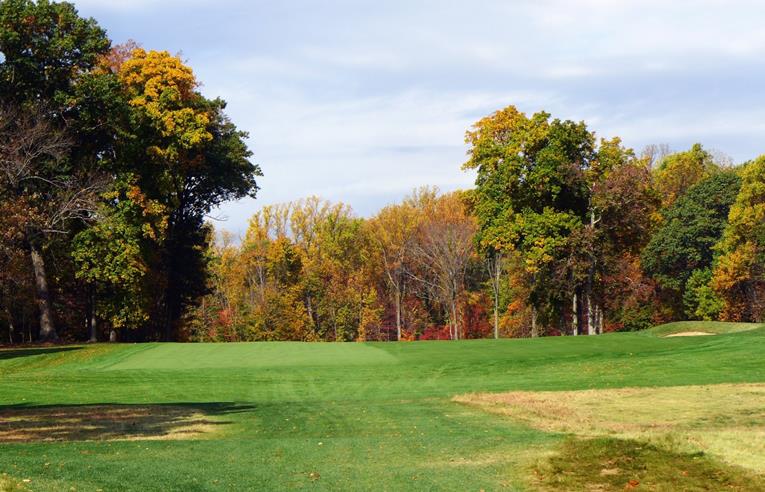
The 13th joins the 3rd, 7th, 9th, 14th, and 18th holes in having the golfer’s tee ball hit and die into an up-slope. Somerset Hills measures 6,784 yards but plays much longer.
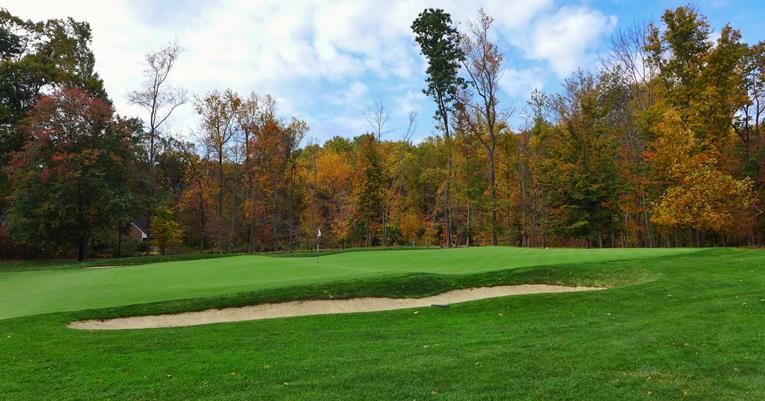
…that’s not the whole story. As seen from the side, the Biarritz qualities finally become evident and today’s hole is even in (!) the swale.
Fourteenth hole, 420 yards, Ridge; By this point in the round, the golfer has witnessed a disturbing amount of times how often his drives hit into up-slopes, leaving him undoubtedly with longer shots into the greens than the scorecard suggests. It happened at the last and it happens again here as the same ridge bisects both fairways. The golfer has every right to be grumpy too because both greens are scintillating with a two putt saved for only those that place their approach on the appropriate part of the green for that day’s hole location. At some 8,000 square feet, this might well be the course’s most diverse and interesting putting surface. A plethora of interesting hole locations exist, all of which shine because of how firm the green – and the area before the green – is now routinely presented. In the mid-1980s, the backdrop to the green was a forest and the green was one of the softer, more receptive targets. With the removal of the thicket and the reclamation of nearly 2,000 square feet back to its original size, the green – and therefore the hole – is once again a standout just as it was in Tillinghast’s day. Slawnik cites this green pad as a prime example of ‘Tillinghast’s ability to build an intentional feature that nonetheless sits harmoniously and elegantly on the ground. His ability to build intentional architecture that fits is a marvel and my annual trips to Somerset Hills are always a highlight. I have never left there without learning something that I can apply elsewhere.’

A wildly mischievous green, the demands placed on the golfer vary greatly depending on the hole location. Young notes, ‘Here at the 14th, just like with so many other holes, the entrance to the green sublimely connects to the fairway. Bunkers and rough grab hold of balls that are not struck well enough. Meanwhile, shots struck with authority are seemingly encouraged to find a path to the hole. The connection of fairways to greens is what sets this course apart.’

The 14th green is upper left and this aerial captures how the forest and thicket was removed from behind it. The aerial also shows three of Tillinghast’s all time best putting surfaces: From the right moving clockwise, the 11th, 12th and then up above the 14th.
Fifteenth hole, 405 yards, Happy Valley; The game of golf is more interesting when the golfer is given something to accomplish. In Tillinghast’s day, shaping shots was a cherished art form, and he provided such opportunities throughout the round for the tiger to showcase his talents (e.g. a fade off the first tee, a draw at the second, a fade at the sixth, a draw at the ninth, etc.). Once again, the good player is given a tempting choice off the tee, this time to play a big fade around the dogleg and have his tee ball catch the down slope and tumble to within ~ one hundred yards of the green. Mortals are left with a 6 iron from on top of the hill but what an approach it is! The angled green is set on the far side of a babbling brook with specimen hardwoods behind completing the handsome picture. For those unfamiliar with the area, this portion of New Jersey would dumbfound with its bucolic charm and rounding the corner of this dogleg is the zenith of the round for many. This hole features exquisite playing angles and Young explains: ‘For a number of years now the concept of “shot angles” and their importance in great hole design has been espoused as being singularly important. Tilly described this principle differently; he believed that each hole should have a “master trap” that would define how best to play, and not play, the hole. He viewed these lines of play as a punishment for a poorly played or gambled shot, a reward for the one well-struck, and most important of all, how it would teach a player to understand the game better and thereby improve his own. If his designs stand as schools of the game, then Somerset Hills is his Ivy League university.’
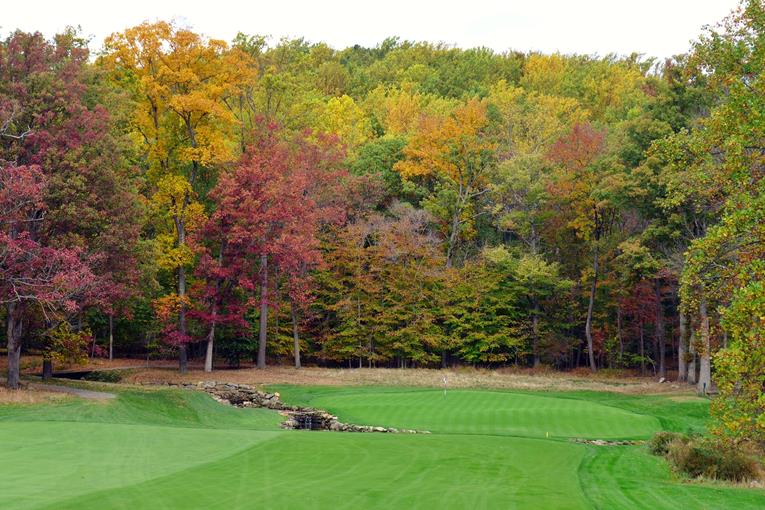
… will do nicely and sets up the golfer for this approach. The hole’s playing angles are flawless as there is a significant advantage to hugging the inside of the dogleg with one’s tee ball.
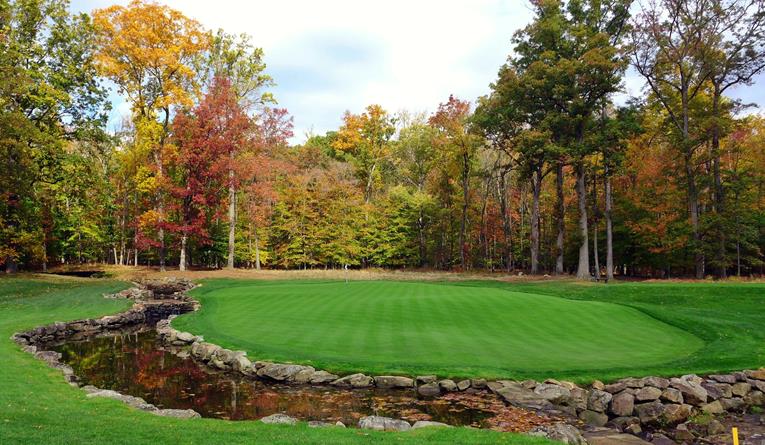
The putting surface was expanded in recent years so that it once again fully occupies the space that it did in Tillinghast’s day.

Young writes that, ‘One should study every hole from BEHIND the green, for it is only there that one can appreciate the best angle of play and, more often than not, it isn’t the one seen from the tee.’ That suggestion is certainly applicable to the 15th.
Sixteenth hole, 170 yards, Deception; What makes an outstanding quartet of one shotters? The superficial answer is of course … four great holes (!) but that fails to take into account how the four holes relate to one another. During the author’s round here in 2018, he hit to the four greens a 22 degree hybrid, a three wood, an eight iron and a six iron. In short, perfect spacing. While this one garners less remarks than the three that have preceded, it poses just as stern an ask. At this late stage in one’s match, the man who is up might well try and steer the ball, which generally results in a flare right – and death.
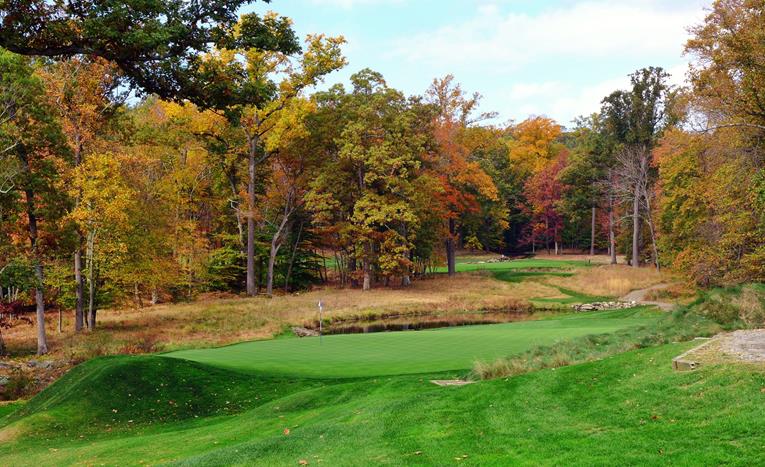
This view from behind shows some of the work required to bench the green into the hillside. Chasing after back right hole locations is a fool’s errand.
Eighteenth hole, 345 yards, Thirsty Summit; Admittedly, this is no one’s favorite hole but that does not mean it isn’t a good golf hole. The fact that it measures sub-350 yards wouldn’t have bothered Tillinghast in the least, given his devotion to The Old Course at St. Andrews, North Berwick and Prestwick. In fact, he might have viewed it as ideal based on those very examples. Here, the drive deadens into the most pronounced up-slope on the property, making par a testier proposition than at those three Scottish links. What a shame it would be if Somerset ended in a conventional manner. The Met area is littered with tough two shot finishers by Tilly and the last thing this distinctive course deserves is … an un-distinctive finish!
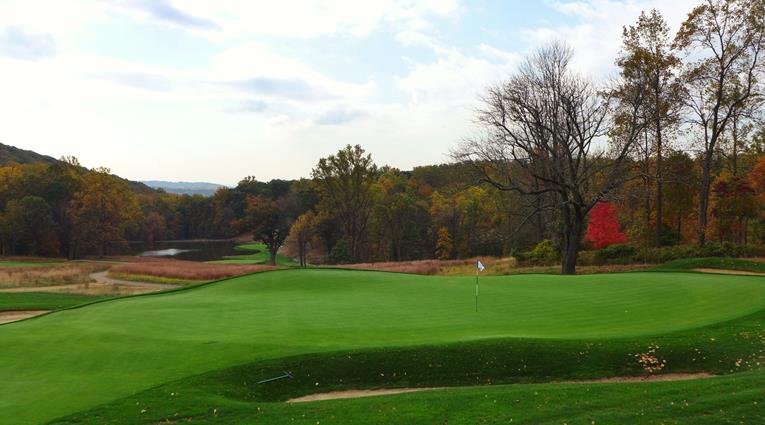
As seen from the clubhouse, the Home green caps off a series of outstanding putting surfaces, each different from the other.
Golf started along the North Sea and the transition of the sport inland to where people lived was not a particularly smooth one. Willie Park Jr., Harry Colt and Herbert Fowler gave it an immense push forward in the early 1900s. Tillinghast was fortunate to study their work, as well as the great links. To the author, Somerset Hills represents the best of old school design features from Britain transposed upon an unusually gorgeous piece of land in North America that happily, remains cloistered to this day from outside hustle and bustle. Thanks to the land’s abundant natural elements and with his trips to Britain fresh in his mind, Tillinghast produced an instant American classic and Slawnik rightly suggests that the greens are a touchstone of design. The club has done an outstanding job over the past two decades in removing clutter and putting a spotlight on Tillinghast’s inspired architecture.
Fads have come and gone since Somerset Hills opened 102 years ago. ‘Championship’ falsely supplanted ‘charming’ in importance in the last half of the twentieth century. Time was shown what folly that was and the pendulum has swung back to what truly matters. There is no higher praise for a design than ‘I would love to play there every day.‘ Somerset Hills fits that criteria – which is the most elusive in golf architecture – as well as any inland course in world golf. It’s that good.
GolfClubAtlas.com profusely thanks Jon Cavalier for the use of his photographs. The best golf course photographs on Instagram are found at Linksgems, run by Jon.


